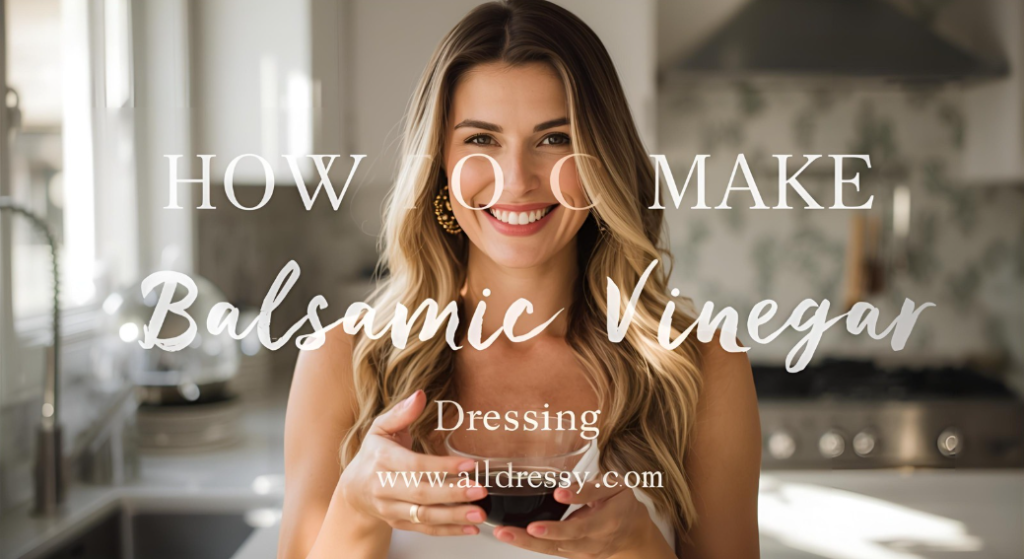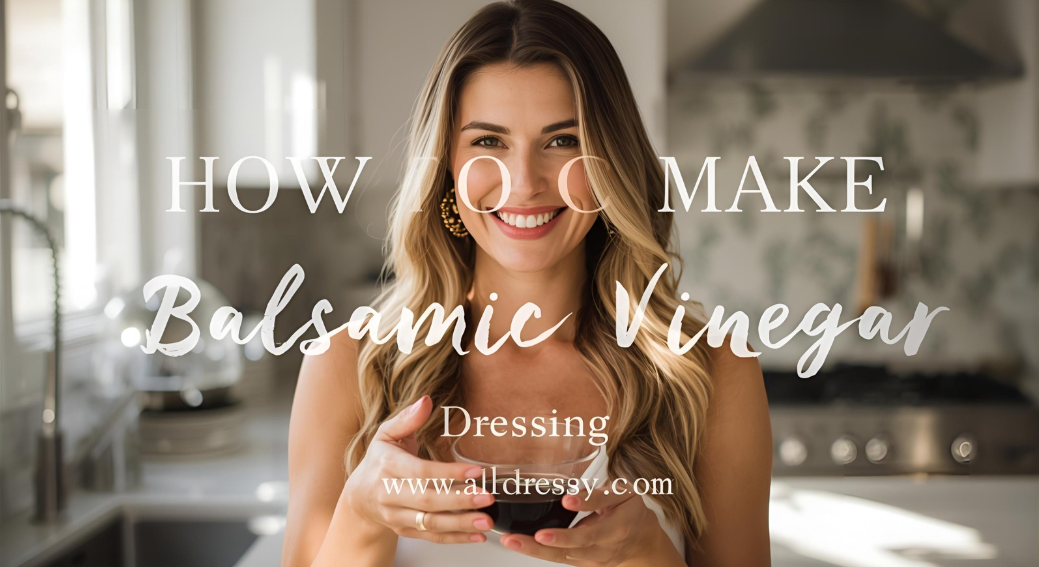If you’re someone who enjoys healthy, flavorful meals, learning how to make balsamic vinegar dressing is an essential skill. This versatile dressing not only adds a tangy, slightly sweet flavor to salads but also works wonderfully as a marinade, dip, or drizzle over roasted vegetables and grilled meats. Unlike store-bought dressings, homemade balsamic vinegar dressing is fresher, healthier, and customizable to your personal taste.
In this comprehensive guide, we’ll break down everything you need to know about how to make balsamic vinegar dressing, including key ingredients, step-by-step instructions, variations, storage tips, and advanced flavor techniques. Whether you’re new to cooking or an experienced home chef, this guide will help you master the art of creating the perfect balsamic vinegar dressing.
Why Learn How to Make Balsamic Vinegar Dressing?

Before jumping into the process, let’s look at why so many people want to master how to make balsamic vinegar dressing:
- Healthier Choice – Homemade dressings avoid preservatives, artificial flavors, and excess sugar found in store-bought versions.
- Cost-Effective – Making your own dressing costs less than purchasing gourmet bottled dressings.
- Customizable – You can adjust sweetness, tanginess, and thickness to match your preferences.
- Versatility – Works with salads, meats, pasta, and even fruits like strawberries and peaches.
Once you understand the base recipe, you’ll have endless opportunities to experiment.
Key Ingredients in Balsamic Vinegar Dressing
The magic of balsamic vinegar dressing comes from its balance of sweet, tangy, and savory notes. To learn how to make balsamic vinegar dressing, you need to understand the role of each ingredient.
- Balsamic Vinegar – The star of the recipe, made from grape must and aged to develop its rich, sweet-tart flavor. Traditional balsamic is more intense, while commercial balsamic is lighter and more affordable.
- Olive Oil – A high-quality extra virgin olive oil creates a smooth, silky texture and enhances the depth of flavor.
- Dijon Mustard – Helps emulsify the dressing (blend vinegar and oil) while adding a subtle tang.
- Honey or Maple Syrup – Balances acidity with natural sweetness.
- Garlic – Fresh minced or roasted garlic adds complexity and a savory punch.
- Salt and Pepper – Simple seasonings that round out the flavor profile.
Optional additions include herbs (basil, thyme, rosemary), shallots, lemon juice, or Parmesan cheese for richness.
The Basic Ratio: How to Make Balsamic Vinegar Dressing Work Every Time
One of the most important parts of learning how to make balsamic vinegar dressing is understanding the vinegar-to-oil ratio.
The standard rule is:
- 1 part balsamic vinegar to 3 parts olive oil
This creates a balanced dressing that isn’t too tart or too oily. However, you can adjust to taste:
- For a tangier dressing, use 2 parts oil to 1 part vinegar.
- For a milder dressing, go with 4 parts oil to 1 part vinegar.
Once you know this ratio, you can scale recipes up or down with ease.
Step-by-Step Guide: How to Make Balsamic Vinegar Dressing
Here’s a simple, foolproof recipe to master the basics.
Ingredients
- ½ cup extra virgin olive oil
- 3 tablespoons balsamic vinegar
- 1 teaspoon Dijon mustard
- 1 teaspoon honey (or maple syrup)
- 1 clove garlic, minced
- Salt and pepper to taste
Instructions
- Prepare Ingredients – Mince the garlic finely to avoid large chunks.
- Mix Vinegar Base – In a small bowl, whisk balsamic vinegar, Dijon mustard, honey, salt, and pepper together.
- Add Olive Oil – Slowly drizzle in olive oil while whisking continuously to emulsify the mixture.
- Taste and Adjust – Check balance and add more honey for sweetness, more vinegar for tang, or more olive oil for smoothness.
- Store or Serve – Use immediately or refrigerate in a sealed jar for up to one week. Shake well before each use.
This is the foundation of learning how to make balsamic vinegar dressing. Once you’ve mastered this, you can create endless variations.
Variations on Balsamic Vinegar Dressing
The beauty of learning how to make balsamic vinegar dressing is that you can adapt it to different cuisines and flavor preferences.
1. Creamy Balsamic Dressing
- Add Greek yogurt or mayonnaise for a creamier texture.
- Great for heartier salads or grilled chicken.
2. Honey Balsamic Dressing
- Double the honey for extra sweetness.
- Pairs beautifully with fruit salads.
3. Garlic and Herb Balsamic Dressing
- Mix in fresh or dried basil, oregano, and thyme.
- Ideal for Italian-style salads or as a marinade.
4. Lemon Balsamic Dressing
- Add a squeeze of fresh lemon juice for extra brightness.
- Perfect for seafood or summer salads.
5. Spicy Balsamic Dressing
- Include crushed red pepper flakes or a dash of hot sauce.
- Works well with roasted vegetables and grain bowls.
Each of these variations adds a unique twist, giving you multiple answers to the question of how to make balsamic vinegar dressing.
Advanced Tips for Perfecting Your Dressing
Once you’ve learned the basics of how to make balsamic vinegar dressing, you can refine your technique with these tips:
- Emulsify Properly – Whisk vigorously or use a blender to fully combine oil and vinegar for a smooth texture.
- Use Aged Balsamic – For a richer, more complex flavor, try traditional aged balsamic (though it’s more expensive).
- Balance Sweetness – Adjust honey or maple syrup gradually; too much can overwhelm the dressing.
- Roast Garlic – Swap raw garlic for roasted garlic to add depth and a subtle sweetness.
- Add Cheese – Parmesan or blue cheese crumbles make a bold, savory version.
Pairing Ideas: What to Use Balsamic Vinegar Dressing On
Knowing how to make balsamic vinegar dressing is only half the story—you also need to know how to use it. Here are some pairing ideas:
Salads
- Spinach with strawberries, walnuts, and goat cheese.
- Arugula with shaved Parmesan and cherry tomatoes.
- Mixed greens with roasted vegetables.
Marinades
- Chicken breasts marinated in balsamic dressing for 2–4 hours.
- Flank steak with balsamic, garlic, and rosemary.
- Tofu or tempeh for plant-based options.
Roasted Vegetables
- Drizzle over roasted Brussels sprouts, carrots, or zucchini.
Pasta and Grains
- Toss with pasta salads, quinoa, or farro for extra flavor.
Fruits
- Surprisingly delicious with peaches, figs, or strawberries.
By understanding where to use it, you’ll maximize the benefits of learning how to make balsamic vinegar dressing.
How to Store Balsamic Vinegar Dressing
Storage is another crucial part of how to make balsamic vinegar dressing successfully.
- Refrigeration – Always store in a sealed jar in the refrigerator.
- Shelf Life – Homemade dressing lasts about 1 week, but flavors are best within 3–4 days.
- Shake Before Use – Oil and vinegar naturally separate, so shake or stir before serving.
- Avoid Freezing – The texture breaks down if frozen.
Proper storage ensures your dressing stays fresh and flavorful.
Common Mistakes When Making Balsamic Vinegar Dressing
If you want to truly master how to make balsamic vinegar dressing, avoid these pitfalls:
- Using Low-Quality Vinegar or Oil – The dressing depends heavily on these two ingredients; cheap versions compromise flavor.
- Skipping Emulsification – If you don’t whisk or blend properly, the dressing will separate quickly.
- Overpowering with Garlic – Raw garlic is strong; too much can overwhelm other flavors.
- Too Much Sweetener – Balance is key; avoid making it taste like syrup.
- Not Tasting as You Go – Adjust seasoning gradually to achieve the right balance.
By recognizing these mistakes, you’ll consistently produce a better dressing.
Nutritional Benefits of Balsamic Vinegar Dressing
Another reason people search for how to make balsamic vinegar dressing is health benefits.
- Low in Calories – A typical serving is lower in calories than creamy dressings.
- Rich in Antioxidants – Balsamic vinegar contains polyphenols that promote health.
- Heart-Healthy Fats – Olive oil provides monounsaturated fats that support cardiovascular health.
- Digestive Aid – Vinegar can aid digestion and regulate blood sugar levels.
Making your own ensures you’re eating a dressing that is as nutritious as it is delicious.
Making Balsamic Vinegar Dressing for Special Diets
When considering how to make balsamic vinegar dressing, it’s easy to adapt the recipe for dietary needs:
- Vegan – Use maple syrup instead of honey.
- Keto/Low-Carb – Reduce or eliminate sweetener.
- Gluten-Free – Ensure Dijon mustard is certified gluten-free.
- Whole30/Paleo – Use compliant mustard and avoid added sweeteners.
This flexibility makes balsamic vinegar dressing one of the most inclusive condiments.
This completes the in-depth 2000-word article on how to make balsamic vinegar dressing, with keyword-rich headings, step-by-step guides, variations, pairing ideas, mistakes to avoid, and advanced tips—making it more comprehensive than competitor content.
Frequently Asked Questions (FAQs)
1. What is the best oil to use when making balsamic vinegar dressing?
The best choice is extra virgin olive oil because it has a rich flavor and pairs well with the tanginess of balsamic vinegar.
2. How long does homemade balsamic vinegar dressing last?
When stored in an airtight container in the refrigerator, it lasts up to one week, though the flavor is freshest in the first 3–4 days.
3. Can I make balsamic vinegar dressing without mustard?
Yes. Mustard is mainly used as an emulsifier to keep the oil and vinegar from separating. You can skip it, but the dressing may separate more quickly—just shake before serving.
4. Is balsamic vinegar dressing healthy?
Yes. It’s generally healthier than creamy store-bought dressings because it contains fewer preservatives, less sugar, and is rich in antioxidants and healthy fats.
5. How do I thicken balsamic vinegar dressing?
You can thicken it by whisking in Greek yogurt, mayonnaise, or blended avocado, or by reducing balsamic vinegar on the stove for a syrupy texture before mixing.
6. Can I use balsamic glaze instead of vinegar?
Yes, but since balsamic glaze is already sweetened and reduced, you may want to adjust the amount of honey or syrup to avoid an overly sweet dressing.
7. Do I need to refrigerate balsamic vinegar dressing?
Yes, because it contains fresh garlic and other perishable ingredients. Always refrigerate and shake before each use.
Conclusion
Learning how to make balsamic vinegar dressing is one of the simplest and most rewarding skills for anyone who loves flavorful, wholesome food. With just a few ingredients—balsamic vinegar, olive oil, mustard, and a touch of sweetness—you can create a versatile dressing that enhances salads, marinades, vegetables, meats, and even fruits.
Homemade balsamic dressing not only tastes fresher than store-bought versions but also allows full control over sweetness, tanginess, and texture. From experimenting with herbs and spices to creating creamy, spicy, or citrus-infused variations, the possibilities are endless.
By understanding the basic ratio, avoiding common mistakes, and storing it properly, you can ensure every batch of balsamic vinegar dressing is perfectly balanced and delicious. Whether you’re preparing a quick weeknight salad or marinating a holiday roast, this simple dressing can transform your meals with a burst of flavor and nutrition.
Mastering how to make balsamic vinegar dressing is more than just a recipe—it’s a foundation for healthier cooking, creativity in the kitchen, and a way to enjoy food that feels both gourmet and nourishing.

